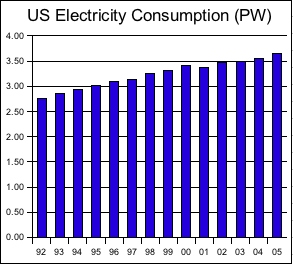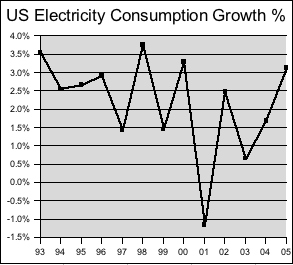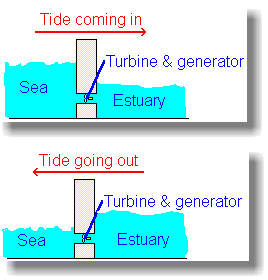Archive for October, 2006
US Energy Consumption
Do you think, over the next 10 years, that US electricity consumption will increase or decrease?
An interesting question, there are constant conservation programs and there is ever improving technology (like Sun’s Ultra T1 processor,) but do you think that’s enough to offset any increase in demand?
Sometimes a historical look can be illuminating when attempting to answer these sorts of questions. The chart below shows in Petawatt hours (a petawatt is 1,000,000,000,000,000 watts) how electricity production has grown since 1992 in the US. For our international readers, I apologize, I’m not taking a global position on this, only a US-centric position. Well, frankly, because I live here and it’s big enough to be undigestable with the US alone. Notice that there is an aggregate increase of nearly a petawatt hour in the amount of electricity consumed over the past 13 years.

Data based on Electric Power Monthly Report
A percentage view of electricity consumption over time shows the growth is assuredly not linear. From 1992 to 2005 the aggregate growth in electricity consumption is 32.4%. There does seem to be a correlation between electricity consumption and the overall health of the economy. Note the relatively high growth rate in 1999 (Dotcom bubble) and the negative growth rate in 2001 (post bubble, 9/11) – both of these years vary considerably from the average annual growth rate of 2.2%. It is also interesting to note that the growth rate in 2005 is 3.1%, the fourth highest percentage in the measurement period. Which begs the question, are we in the midst of another bubble?

Data based on Electric Power Monthly Report
Returning to the questions above, will demand for electricity increase or decrease and what, if any impact with conservation and technology have on the trend, I believe we’ll continue to see an increase in demand. Even a fraction of a % of growth in demand spurs the need for more energy generation. And that’s interesting.
Technorati Tags: Electricity | Consumption | Energy
What is green and fast?
Audi R10 Racing Diesel

When Rudolf Diesel patented his compression engine (air is compressed, the temperature rises, fuel is injected and ignites without a spark) I doubt he ever envisioned cars like the Audi above. The current generation of diesels are powerful and increasingly green as their emissions are treated. Combine that with Biodiesel fuel, and you’ve got a winning combination. Here’s an interesting article about this topic.
Technorati Tags: Diesel | Racing | Biodiesel
Tidal Barrage
No, it’s not the next disaster, it’s a way to harnass the power of the ocean’s tides to generate power.
Rance river barrage in France generates 240 Megawatts (MW)

What is a barrage you ask? Effectively, it is a barrier is built across a cove or inlet that provides a dam effect either keeping the tide out of the protected area or in it. Once the tide reaches the high or low line, the stored water is then released through turbines attached to generators to create power.
Images showing the concept

Since tides are predictable, this is an effective way of generating power in an entirely renewable manner. There are some negatives to this approach including generation time, it’s only part-time when the water is at the right level, cost, and potential environmental impacts (similar to dams in some respects.) While tidal barrages won’t solve the energy challenge single handedly, it’s possible this approach can be a part of some larger solution.
Technorati Tags: Energy | Renewable | Tidal Barrage








